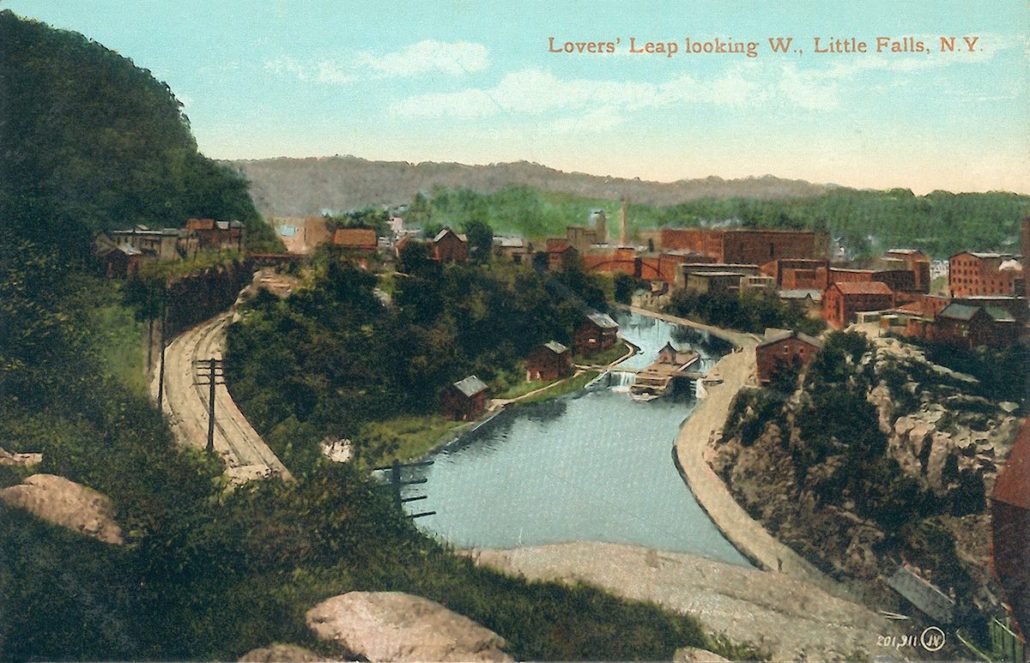This day in Mohawk Valley history: March 23, 1909
Little Falls: Work Begun on Another Contract.

Lovers’ Leap looking W., Little Falls, N.Y. (201,911 — Valentine & Sons’ Publishing Co., New York) — postmarked Apr. 12, 1909
Busy Times Down the Valley in Digging the Big Canal
Little Falls, March 23 (Special) – The barge canal zone in this city will be a busy place this summer. Yesterday, Contractors Shay, Lathrop & Henwood of Buffalo began work on a sub-contract in the western end of the city. Their contract calls for about $200,000 worth of the work in this city and is for the slice of the canal near Hansen Island, where the new canal will enter the river. The machinery for the new contractors arrived yesterday and is being unloaded to-day. Things will hum from now on in the zone. The original contractors, Casey & Murray, are busy in the east end with the gigantic lock which lifts the boat from the Mohawk river to the level of the proposed canal, a distance of 42 feet. The McCaghey Company are busy at what is called the “Calubra cut” in the center of the work and the new contractors are at work on the other end.
Source: NYS Historic Newspapers
THE INCEPTION OF
THE BARGE CANAL PROJECT
By FRANCIS VINTON GREENE
Major General U.S. Volunteers, Chairman Committee on Canals of New York State, 1899.
In many respects the barge canal project is comparable in extent, in magnitude, and in results with the Panama canal project; but in comparison with the immense resources of the imperial State of New York, in comparison with the vast sums which the city of New York is expending for public works, in comparison with the equally vast sums which the great railroad systems have within the last few years expended and contemplate expending in the immediate future, the expenditures for the barge canal are small. If, as it is confidently expected, they produce the desired results and retain the supremacy of the great trade route through the State of New York between the lakes and the ocean, then the price to be paid, measured by the results obtained, is almost insignificant.
[From: Buffalo Historical Society Publications, vol. 13, 1909]
“At the beginning of the 20th century, as the size of freight boats increased and technology replaced the horse and mule as means of locomotion, the need for a much larger canal was again evident. In many locations the footprint of the Erie Canal was enlarged and brought into existence as the new Barge Canal, but in the Little Falls area the Mohawk River served the purpose. The Mohawk River east and west of Little Falls was deepened to at least 14 feet and straightened (islands were dredged out and points of land jutting out into the river were sliced off.) In Little Falls a whole new river/canal channel was dug south of Lock Island, concrete walls were poured, a massive double door guard gate was erected and Lock 17 was built replacing the four Erie Canal locks. Completed in 1918, the Barge Canal lopped off much of Loomis/Seeley/Moss Island displacing many of the buildings on the island. Also, Goat Island was created by the heightened water level. The final product looked much as it does today.” – Excerpt from Evolution of Little Falls Waterways by David Krutz, Little Falls Historical Society












![Detroit Publishing Co., Publisher. Erie Canal, Utica, N.Y. [Between 1900 and 1915] Photograph. Retrieved from the Library of Congress, <www.loc.gov/item/2016810887/>. Detroit Publishing Co., Publisher. Erie Canal, Utica, N.Y. [Between 1900 and 1915] Photograph. Retrieved from the Library of Congress, .](https://mohawkvalleymuseums.us/wp-content/uploads/2024/03/IMG_3599-705x561.jpeg)

 Sugaring set up at mansion. Photo provided by the Herkimer Home State Historic Site.
Sugaring set up at mansion. Photo provided by the Herkimer Home State Historic Site.